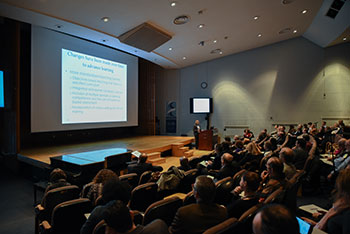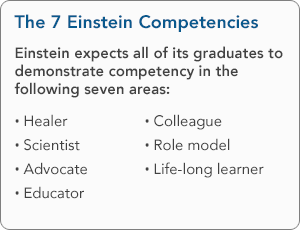

Thought Leaders
Brainstorming for Curriculum Reform: The Education Thought Leaders Conference
Think outside the box. Dream big. Imagine new ways for Einstein to give graduates every advantage in the ever-changing world of medicine. Thoughts like these were in the minds of some 130 attendees at Einstein’s first Thought Leaders Conference on curriculum reform, held earlier this year in the Education Center and the Mary and Karl Robbins Auditorium.

Dr. Maryellen Gusic addresses participants during her keynote address at the Thought Leaders Conference In response to a call from the Association of American Medical Colleges (AAMC) and other organizations, medical schools across the country have been redesigning their curricula. The Thought Leaders Conference—which kicked off the Einstein initiative—was the brainchild of Dr. Martha Grayson, Einstein’s senior associate dean for medical education.
She explained, “Our approach enabled faculty, students and members of the Bronx community to share their visions for a new Einstein curriculum.”
Keeping Pace with Change
Why the big push to reshape curricula now? Because, as Dr. Allen M. Spiegel, Einstein’s Marilyn and Stanley M. Katz Dean, said in his opening remarks: “Change is necessary to move forward and assure that our students are well-equipped to navigate the challenges posed by an ever-changing healthcare environment.”
Dr. Grayson said, “More than ever before, graduating medical students face an endless flood of new scientific information, constant advances in technology, continual restructurings of healthcare delivery and financing, and changes in society.”
 “Medical education needs to be aligned with what’s happening in the healthcare environment, and its overarching goal should be to improve health outcomes,” said the event’s keynote speaker Dr. Maryellen Gusic, president of the Academic Pediatric Association and a past chief medical education officer at the AAMC.
“Medical education needs to be aligned with what’s happening in the healthcare environment, and its overarching goal should be to improve health outcomes,” said the event’s keynote speaker Dr. Maryellen Gusic, president of the Academic Pediatric Association and a past chief medical education officer at the AAMC.
Dr. Gusic presented the elements of an effective education program: it emphasizes physician competencies (see box at right), stimulates students to inquire and innovate, strives to meet students’ different learning needs, assesses learning outcomes and encourages students to develop professional values, actions and aspirations.
Dr. Grayson followed Dr. Gusic with a presentation on engagement as the “heart of the process,” and noted the large turnout was an indication that members of the Einstein community were willing to join the effort, which was long overdue. “I hope every person in this auditorium is ready to make a commitment to producing an outstanding new type of physician and physician-scientist for the future,” she said. “We can’t do this without you.”
Stimulating Presentations and Discourse
Next came more than 40 “vision presentations”—the result of prodigious planning. Dr. Grayson explained, “For this part of the conference, we followed a format similar to that of a national educational meeting, sending out calls for presentation proposals.”
Two abstract selection committees reviewed 93 high-quality proposals from faculty members and students. “We published all the proposals and were able to work out the logistics for running talks in seven concurrent rooms, with six live presentations from each,” noted Dr. Grayson. “This allowed for sharing many more ideas with the newly formed CDEC [Curricular Design Executive Committee] than individual presentations would have.” Topics ranged from curricular themes and the structure of a medical school curriculum to teaching methods and effective assessments.
The conference generated a flurry of Twitter tweets along with vocal support from Bronx community members who had worked with students as patients or in a supervisory capacity. They contributed many ideas for consideration in the new curriculum and for producing patient-centered doctors.

Group discussions were an important component of the day’s activities“They commended us on this huge undertaking and voiced their willingness to assist in any way that we see fit,” said Heather Archer-Dyer, director of community health outreach and an instructor in the family and social medicine, who presented a talk on developing a community-based service-learning curriculum. (Service-learning is an educational experience centering on a collaborative partnership between college and community.)
“Community members’ perspectives are essential to creating a curriculum that will help students understand health grounded in the Bronx,” she added. “We can’t create a new curriculum or produce new types of physicians that meet the needs of the community without listening to patients and the community.”
“The overall mood of the conference was one of great excitement,” recalled Dr. Pablo Joo, assistant dean for medical education and CDEC member, who greeted the community leaders and encouraged tweeting.
“The speakers were all terrific, and everyone felt included, heard and empowered,” added Dr. Victor Schuster, a senior vice dean at Einstein and a moderator of the conference. “It became clear that people are in silos toiling seemingly alone on themes of their passion, and what became apparent was a sort of ‘Wow, I am not alone!’ awareness. One person said to me, ‘This was the best thing I’ve ever taken part in at Einstein.’”
Looking Ahead
“The objective of the Thought Leaders conference was to engage the community and get their ideas, and we accomplished that,” said Dr. Grayson.
What’s next? Working groups comprising faculty, students and community members are reviewing the tremendous number of ideas generated at the conference. They’ll sort them into specific areas of the curriculum and assess the logistics for putting them into practice. Curricular updates will occur over four years—on a rolling basis—beginning in the fall of 2017 with the class of 2021.
The conference was a major collaborative effort. Members of the abstract selection committee—who evaluated nearly 100 submissions in less than a week—were Drs. Grayson, Ellise Delphin, Rachel Katz, Terence Ma, Fernando Macian-Juan, Keith Metzger and Helen Rhim, and Ms. Elizabeth Koltz. Student Andrew Telzak helped Ms. Archer-Dyer choose and invited community leaders. Dr. Christina Coyle, Camille Robinson and Martin Penn coordinated logistics. In addition to the 42 presenters, there were seven faculty and six student moderators. Dr. Ma and his staff ensured that all presentations were videotaped and then uploaded to the website.
Photo Gallery
(To view slideshow of photo gallery, click on an image below; then move your mouse over the left or right margins to navigate.)
Posted on: Monday, April 25, 2016

















Tablet Blog